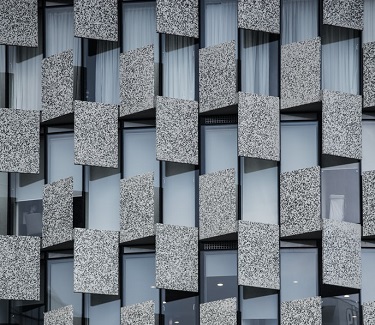Green Star building facade and NCC Compliance
Green Star is a voluntary or mandatory rating scheme for the buildings. It rates buildings based on how sustainable the building design and construction is. This system benchmarks proposed buildings against several sustainability categories. The outcome of the Green Star assessment is several points together generate a star rating, ranging from 1 to 6. One of the main sustainability categories is Energy Use and the most contributing impacting factor there is wall-glazing construction.


Energy Use Compliance Requirements for Green Star
Compliance with Green Star Energy Use could be met by satisfying Minimum Expectation. You can achieve points by further reducing the proposed building’s energy use. Summary of the compliance criteria is presented below:
- Minimum Expectation (mandatory – no points): the building’s energy use is at least 10% less than a reference building (on-site renewable energy offset excluded).
- Credit Achievement (voluntary – 3 points): the building’s energy use is at least 20% less than a reference building (on-site renewable energy offset included).
- Exceptional Performance (voluntary – 3 points): the building’s energy use is at least 30% less than a reference building (on-site renewable energy offset included).
In addition to the above, there are further mandatory compliance conditions that the proposed building must meet. One of which is the compliance of the proposed building wall-glazing construction to the requirements of the NCC, Section J, Part J1.5.
According to the Green Star Energy Use Calculation Guide:
The performance of wall-glazing constructions and display windows (J1.5) must comply with the total system R value, total system U value and system SHGC requirements, inclusive of thermal bridging effects.
[Green Star Energy Use Guide, Version 1, September 2021, Calculation Requirements, Page 10]
This indicates that aside from the mandatory or voluntary compliance requirements, the proposed building wall-glazing construction must meet the Section J1.5 minimum requirements. For example, if the proposed building energy use is 20% less than the reference building having far more superior services, you won’t get a pass unless the requirements of Part J1.5 are met also.
BCA Facade Requirements (Compliance with Part J1.5)
Conditions to satisfy Part J1.5 (wall-glazing) requirements can be categorized into three major groups:
Minimum Wall R-value
Despite window U-value, walls are required to have minimum R-value. Depending on the Building Class, Climate Zone and the wall ratio (% of wall to total wall-glazing construction on each orientation):
- Wall ratio less than 20%:
- All Building Classes:
R1.0 – for all Climate Zones
- All Building Classes:
- Wall ratio more than 20%:
- Class 3/9c/9a ward area:
R3.3 – for Climate Zone 1
R1.4 – for Climate Zone 2 & 5
R2.8 – for Climate Zones 4, 6 & 7
R3.8 – for Climate Zone 8 - Other Building Classes:
R2.4 – for Climate Zone 1
R1.4 – for all other Climate Zones
- Class 3/9c/9a ward area:
[NCC Vol 1.0, Section J, Part J1.5 (d)]
Maximum Solar Admittance
Solar admittance means a fraction of incident irradiance on a wall-glazing construction that adds heat to the building’s space. In other words, selected window SHGC contribution to the building thermal energy use. The maximum acceptable solar admittance depends on the Building Class, orientation of facade and Climate Zone:
Class 3/9c/9a ward area:
0.07 – for all Climate Zones (excluding 2, 5 & 8)
0.08 – for Climate Zone 8
0.10 – for Climate Zone 2 & 5
All other Building Classes:
0.12 – for Climate Zone 1
0.13 – for all Climate Zones (excluding 1, 3 & 8)
0.16 – for Climate Zone 3
0.2 to 0.42 – for Climate Zone 8
[NCC Vol 1.0, Section J, Part J1.5, Tables J1.5b & J5.1c]
Total System U-value
for the purposes of Volume One, means the thermal transmittance of the both walls and glazing allowing for the effect of any airspaces, thermal bridging and associated surface resistances. This means that the composite effect of walls thermal resistance and windows U-value must be taken into consideration.
Total System U-value if a facade depends on Building Class and Climate Zone. According to Part J1.5, maximum acceptable Total System U-value are:
Class 3/9c/9a ward area:
U0.9 – for Climate Zone 8
U1.1 – for all Climate Zones (excluding 2, 5 & 8)
U2.0 – for Climate Zone 2 & 5
All other Building Classes:
U2.0 – for all Climate Zones
[NCC Vol 1.0, Section J, Part J1.5 (a)]
What is the benefit of Performance Solution?
Many architects and builders seek to reduce construction costs through pathways like JV3 Performance Solution. This is certainly the case where you need to have clear windows with higher U-values, regardless of restrictions of Part J1.5. Through Alternative Solutions, it’s easy to work on improvements to the building insulation or services (e.g. chiller COP) to compensate. However, you can not do this with Green Star modelling even if the Proposed building uses 20% less energy compared to the Reference building. So why is this problematic?
Referring to the above, it is obvious that some Building Classes have a difficult time complying with the code. For example, if you are building a hotel (Class 3) in Hobart (Climate Zone 7) and like to obtain a Green Star Rating for it, your options for walls and glazing are limited. And here’s why:
Challenges of minimum R-value
For a hotel located in Hobart, you need to have walls with a minimum R-value of R2.8 (refer above). R2.8 is achievable by adding a 90mm insulation (R2.7) to any wall, only if you don’t take the thermal bridging effect into consideration. Considering the thermal bridging effect, achieving R2.8 with metal wall framing elements is truly a challenge. Addition of thermal breaks and reflective insulation (as well as bulk insulation) could be inevitable if metal wall framing and lightweight cladding is what you are choosing for your facade. The use of concrete walls with rigid insulation to mitigate the thermal bridging effect are preferred if possible.
Challenges of window SHGC
Luxurious hotels often have many windows that are preferred to be non-tinted so the guests could have a nice view of the city. However, a hotel in Hobart with many windows on its facades is not likely to get a pass on Part J1.5. No matter the effect of SHGC on heating demand, or what potentials are available to reduce the energy use of the hotel, clear windows may not be an option. Curtain walls with high-performance Low-E clear glazing may be the only available option that comes at a very high price. An example of this type of glazing is Insulglass LowE Advance that has low SHGC (0.35) and high VLT (0.72).
